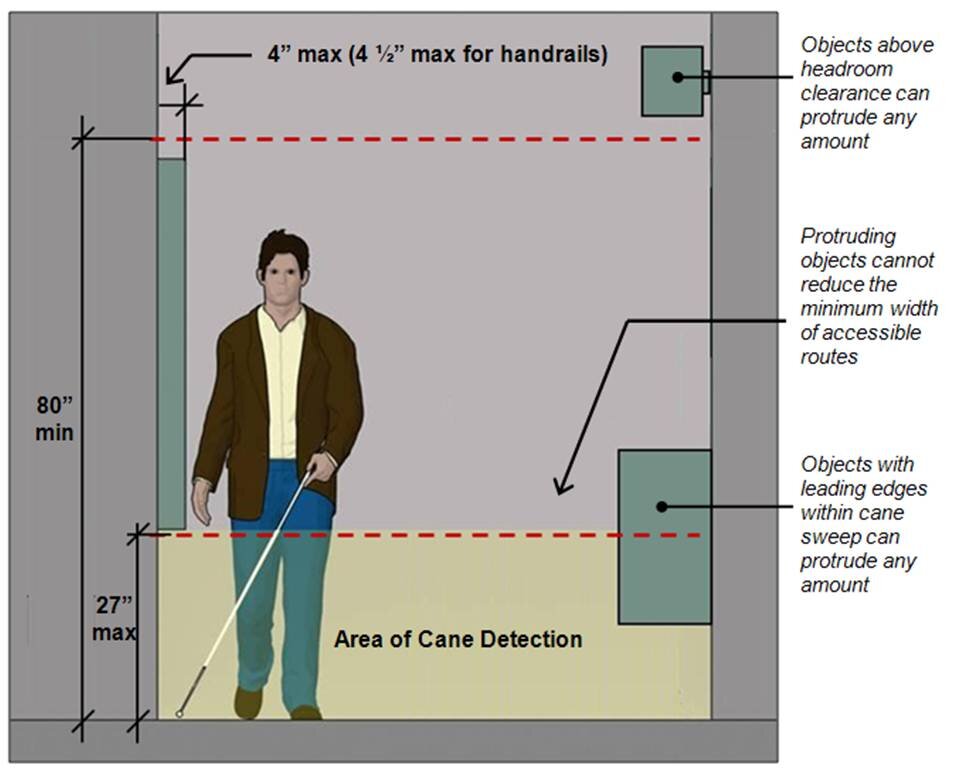Protruding Objects as Defined by the ADA - Technical
Protruding objects are common discrepancies in facilities where the American with Disabilities Act (ADA) Standards apply. This article will discuss the technical requirements for protruding objects. The 2010 ADA Standards that apply the most to protruding objects are 204 and 307.
2010 ADA Standard 204.1, [Protruding Objects] General, states, “Protruding objects on circulation paths shall comply with [Standard] 307. EXCEPTION 1. Within areas of sport activity, protruding objects on circulation paths shall not be required to comply with [Standard] 307. Exception 2. Within play areas, protruding objects on circulation paths shall not be required to comply with [Standard] 307 provided that ground level accessible routes provide vertical clearance in compliance with [Standard] 1008.2.”
2010 ADA Standard 307.2 Protrusion Limits, states, “Objects with leading edges more than 27 inches (685 mm) and not more than 80 inches (2030 mm) above the finish floor or ground shall protrude 4 inches (100 mm) maximum horizontally into the circulation path. EXCEPTION: Handrails shall be permitted to protrude 4½ inches (115 mm) maximum.” The graphic below is representative of the protruding objects limits.
Protruding Objects Limits and Cane Detection Area
Protruding Objects Advisory 307.2, Protrusion Limits, states, “When a cane is used and the element is in the detectable range, it gives a person sufficient time to detect the element with the cane before there is body contact. Elements located on circulation paths, including operable elements, must comply with requirements for protruding objects. For example, awnings and their supporting structures cannot reduce the minimum required vertical clearance. Similarly, casement windows, when open, cannot encroach more than 4 inches (100 mm) into circulation paths above 27 inches (685 mm).”
In other words, protruding objects limitations apply everywhere there is a circulation path, NOT just on accessible routes, unless there is an exception in the Standards. There are not many exceptions. One difference is found in the Architectural Barriers Act (ABA), where a natural element, like a tree, is not considered a protrusion if that natural element is on federal land. Circulation paths include any place a person can be, interior and exterior.
A common installation to avoid the limitations for protruding objects is to recess the element installation. The graphic below is where a drinking fountain is recessed into an alcove so that it does not project out into the circulation path more than 4 inches.
Drinking Fountain Recessed into a Wall
Drinking Fountain in Recessed Alcove
The graphic on the right shows the drinking fountain not more than 4 inches into the circulation path.
Drinking fountains can present a unique situation where they are not recessed in an alcove so they may be a protruding object that must be cane detectable at 27 inches above the finished floor. However, drinking fountains also must allow a forward approach and have space below the fountain for knee and toe clearance, which goes up to 27 inches above the finished floor. The solution is to install the drinking fountain at 27 inches exactly [absolute] above the finished floor, which would then comply with both rules.
The photo below is representative of a protruding object in a grocery store where a scale is installed more than 27 inches above the floor but the pan projects out from the post more than 4 inches.
Grocery Store Produce Scale as a Protruding Object
The photo below is another example where a ticket dispenser is installed more than 27 inches above the floor and extends more than 4 inches from the wall mount.
Ticket Dispenser Mounted More than 27 Inches Above the Floor and Extending More than 4 Inches
The 80 inch rule comes into play in circumstances where the circulation path goes under an overhead projection such as a step system, plumbing installations, HVAC ductwork, or a curved wall, etc. 2010 ADA Standard 307.4, [Protruding Objects] Vertical Clearance, states, “Vertical clearance shall be 80 inches (2030 mm) high minimum. Guardrails or other barriers shall be provided where the vertical clearance is less than 80 inches (2030 mm) high. The leading edge of such guardrail or barrier shall be located 27 inches (685 mm) maximum above the finish floor or ground. EXCEPTION: Door closers and door stops shall be permitted to be 78 inches (1980 mm) minimum above the finish floor or ground.” The graphic below is representative.
Step System Protruding Object Curved Wall Protruding Object
The installations above are accessible because there is a fixed potted plant under the step system and a fixed guard rail installed under the curved wall that provide detectable warnings.
Another common installation that violates the 80 inch rule is when signs are mounted to the ceiling and allowed to hang down too low. The photo below is representative.
Ceiling Mounted Sign as a Protruding Object
Post Mounted Sign Hazard
Protruding object rules apply to post mounted installations like signs even though these signs may not be fixed to the floor. The graphic on the right demonstrates the danger to a person who is site limited and walking near a sign mounted on a post, and the leading edge of the sign is up near their face.
2010 ADA Standard 307.3, Post-Mounted Objects, states, “Free-standing objects mounted on posts or pylons shall overhang circulation paths 12 inches (305 mm) maximum when located 27 inches (685 mm) minimum and 80 inches (2030 mm) maximum above the finish floor or ground. Where a sign or other obstruction is mounted between posts or pylons and the clear distance between the posts or pylons is greater than 12 inches (305 mm), the lowest edge of such sign or obstruction shall be 27 inches (685 mm) maximum or 80 inches (2030 mm) minimum above the finish floor or ground. EXCEPTION: The sloping portions of handrails serving stairs and ramps shall not be required to comply with [Standard] 307.3.” In other words, if the leading edge of the sign is not in the cane detectable area below 27 inches or at least 80 inches above the floor, the sign cannot extend out more than 12 inches from the post, and the space between 2 posts cannot exceed 12 inches. The graphic below is representative of this Standard.
Protruding Object Limits for Post Mounted Elements
Another way to look at the post rules is that post-mounted objects with leading edges 27 inches maximum or above 80 inches can protrude any amount. The graphic below is representative.
Post Mounted Sign Within Cane Detection Post Mounted Sign 80 Inches Above Floor











